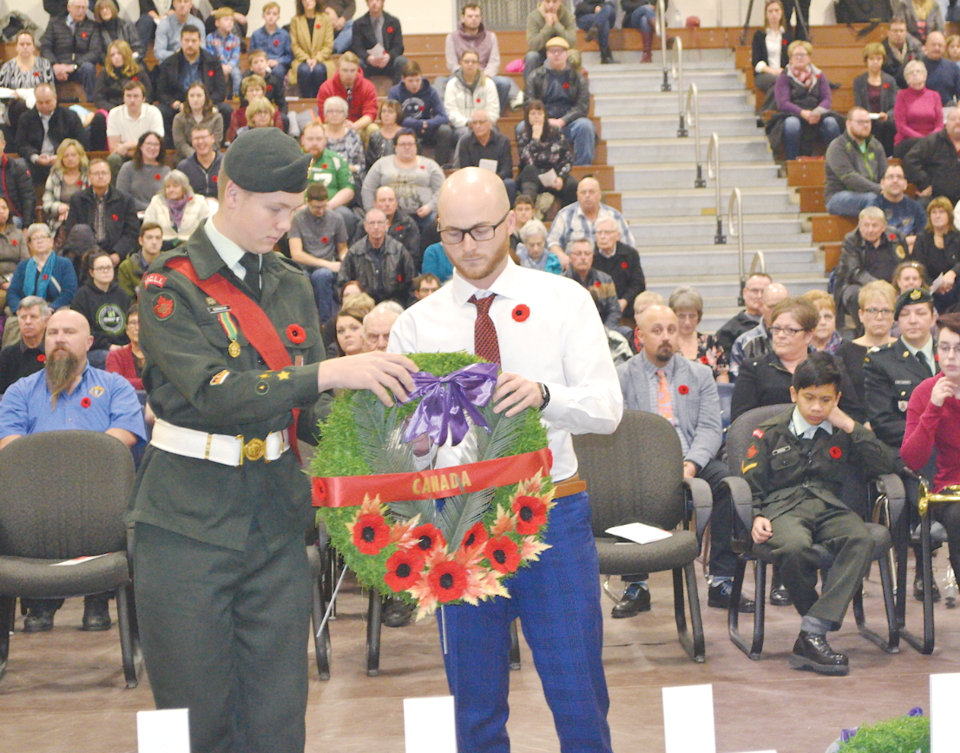This year’s Remembrance Day marked the 100th anniversary of the armistice that marked the end of the First World War.
The Estevan branch of the Royal Canadian Legion wanted to make it a little extra special, with a few new additions to its Remembrance Day service, and a different location to accommodate additional people.
It appears the community responded.
Estevan’s Remembrance Day service was held Sunday morning at the Estevan Comprehensive School’s gymnasium. The service is traditionally held in the school’s cafetorium, with a cenotaph service to follow in the courtyard, but the size of the gym allowed the legion to have everything in one area.
Legion president Lyle Dukart didn’t have a final attendance tally, but he estimates it was in the neighbourhood of 600 people, which is more than they could handle in the cafetorium.
“I thought it went over pretty well, and it was all in one area. Nobody had to shuffle around,” said Dukart.
It was much easier to have everything in one spot, and they didn’t have to worry about people leaving before the start of the cenotaph service.
“I thought it was set up pretty nicely,” said Dukart.
This year’s service featured many of the traditional components of a Remembrance Day service, such as the music, the prayers and the tributes. Two minutes of silence were observed, and the Roll of Honour was read, with the names of the soldiers from Estevan who died in the First World War, the Second World War, the Korean War and the Afghanistan War.
A wreath was placed at the Tomb of the Unknown Soldier.
Seventy-two crosses flanked the cenotaph, paying tribute to the 72 Estevan soldiers who died during the First World War. Silhouettes were also on each side of the cenotaph and near the tomb of the Unknown Soldier to represent the fallen soldiers of the Great War.
During the reading of Flanders Field, Jim Spenst, who was a private in the Canadian Army during the Second World War, passed an unlit torch to Warrant Officer Owen Gudmundson of the No. 2901 Estevan Army Cadets.
The ceremony also had a guest speaker for the first time in several years. Capt. Craig Bird, the commanding officer for the local army cadets who is also a military historian, discussed Canada's contributions to combat missions, and the role Estevan played in the First World War.
“There are 72 names on our cenotaph of people from this area who gave the ultimate sacrifice in battles at Ypres, Passchendaele, the Somme and Vimy Ridge, just to name a few,” said Bird.
The 152nd Battalion recruited from the Estevan and Weyburn areas. When Canada joined the war in August 1914, men flocked to join the army, believing the war may be short and over by Christmas.
“They had to get in there and join up before the excitement ended. It was also the patriotic duty that they felt because of the ties to Great Britain,” said Bird.
While armistice marked the end of the fighting, the war didn’t stop until January 1920 with the Treaty of Versailles.
“It took that long to negotiate the terms of the peace treaty and the reparations that Germany was going to make to the Allies, especially France, for the damage that had been done … over the course of the four years of the war,” said Bird.
Bird also discussed the history of the poppy, and gave background on the famous poem In Flanders Fields by Lt.-Col. John McCrae, a Canadian physician, during the First World War.
McCrae wrote In Flanders’ Field on a scrap of paper in May 1915, the day after the death of a close friend in the second battle of Ypres. It was published in December of that year, and served as an inspiration to an American teacher, who vowed to always wear a poppy as a sign of remembrance.
During a visit to the U.S., a French woman learned of the custom, and decided to make and sell poppies for the children of war-torn areas in France.
The Great War Veterans Association, which was the predecessor to the legion, adopted the poppy of a flower of remembrance on July 5, 1921.
More than 650,000 people from Canada and Newfoundland served in the Great War, Bird said. There were more than 66,000 who died and 172,000 were wounded. Canada’s population was under 8 million people at the time.
Eight per cent of the population was in uniform during the war, and many more served at home to provide for the war effort. The average age of the soldiers was 26.
Bird also brought some of his memorabilia from the First World War to the gymnasium for the ceremony. People paused to view the collection before and after the ceremony.
Dukart said he was impressed with Bird’s speech, and the research Bird has conducted.
In recent years, a multimedia presentation has taken the place of a guest speaker at Estevan’s Remembrance Day service.
During the cenotaph service, representatives from governments, protective services agencies, service groups and youth organizations placed wreaths around the cenotaph, which was guarded by members of the army cadets and the No. 30 Wylie-Mitchell Air Cadets.
Once the cenotaph service was over, people were invited to drop their poppies off at the foot of the cenotaph.
Dukart believes there was more awareness of the service and of Remembrance Day this year because it was the 100th anniversary of the signing of the Armistice.
He also said it’s too early to tell whether the legion will continue to have the service in the gymnasium, or if they would do it occasionally in the gym on milestone years. They still need to get feedback from those who participated and attended the service.



